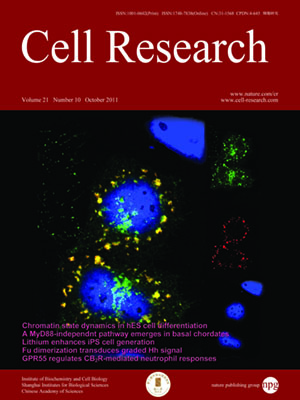
Volume 21, No 10, Oct 2011
ISSN: 1001-0602
EISSN: 1748-7838 2018
impact factor 17.848*
(Clarivate Analytics, 2019)
Volume 21 Issue 10, October 2011: 1436-1451
ORIGINAL ARTICLES
Transduction of the Hedgehog signal through the dimerization of Fused and the nuclear translocation of Cubitus interruptus
Yanyan Zhang, Feifei Mao, Yi Lu, Wenqing Wu, Lei Zhang and Yun Zhao
State Key Laboratory of Cell Biology, Institute of Biochemistry and Cell Biology, Shanghai Institutes for Biological Sciences, Chinese Academy of Sciences, Shanghai 200031, China
Correspondence: Yun Zhao, Lei Zhang,(yunzhao@sibs.ac.cn; rayzhang@sibs.ac.cn)
The Hedgehog (Hh) family of secreted proteins is essential for development in both vertebrates and invertebrates. As one of main morphogens during metazoan development, the graded Hh signal is transduced across the plasma membrane by Smoothened (Smo) through the differential phosphorylation of its cytoplasmic tail, leading to pathway activation and the differential expression of target genes. However, how Smo transduces the graded Hh signal via the Costal2 (Cos2)/Fused (Fu) complex remains poorly understood. Here we present a model of the cell response to a Hh gradient by translating Smo phosphorylation information to Fu dimerization and Cubitus interruptus (Ci) nuclear localization information. Our findings suggest that the phosphorylated C-terminus of Smo recruits the Cos2/Fu complex to the membrane through the interaction between Smo and Cos2, which further induces Fu dimerization. Dimerized Fu is phosphorylated and transduces the Hh signal by phosphorylating Cos2 and Suppressor of Fu (Su(fu)). We further show that this process promotes the dissociation of the full-length Ci (Ci155) and Cos2 or Su(fu), and results in the translocation of Ci155 into the nucleus, activating the expression of target genes.
Cell Research (2011) 21:1436-1451. doi:10.1038/cr.2011.136; published online 16 August 2011
FULL TEXT | PDF
Browse 2097


